Raising Water Consciousness through
World’s Biggest Photo Exhibition and
Largest collection of Photo Stories on Water
Photo Stories | Water and EnvironmentA story based on the theme of World Water Day 2022
Groundwater Pollution from Domestic Wastewater, Solid Waste and Drinking Water
Nandita Singh and Om Prakash Singh
28 February, 2023
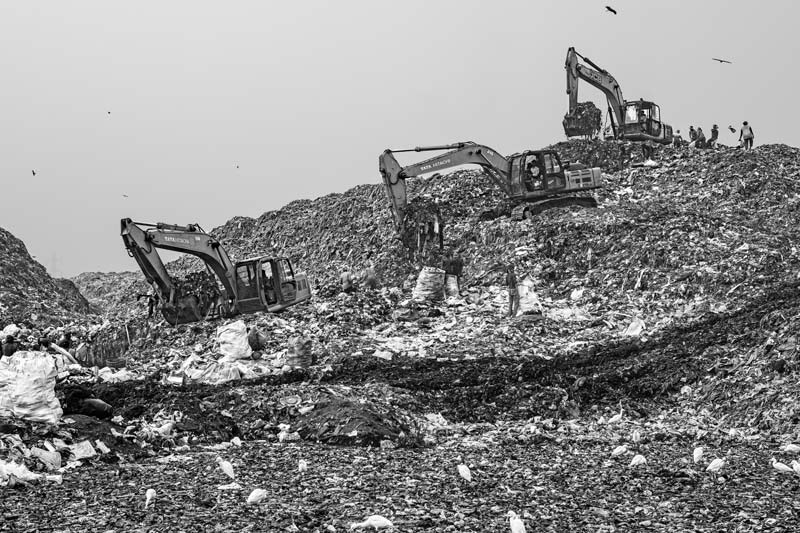
Groundwater - the large water volumes present below the land surface in pores, fissures and other voids within underground geological units - accounts for approximately 99% of all liquid freshwater available on Earth. It is ‘invisible’ but highly valuable due to the various services it offers for society and nature. India has abundant ground water reserves which help meet the diverse water needs. According to the Central Ground Water Board (CGWB), groundwater supports 85% of the domestic water and up to 60% of total irrigation requirements of the country. Amidst this centrality, a serious concern is the rapidly declining quality of groundwater. This is primarily a result of diverse human actions that cause groundwater pollution through different pathways. This photo story focuses on those pathways where the pollutant is capable of finding its way from the source into groundwater aquifers through the soil, from different sources within urban and rural settlements, namely, domestic wastewater, solid waste and drinking water. The wastewater generated at household scale can be of two kinds. First is greywater resulting from washing, bathing and cleaning activities, and second is blackwater emerging from toilets that ordinarily contains urine and feces. The larger volume is comprised of greywater (50-80%) which generally contains a variety of chemical pollutants, such as nitrate and phosphorous from soaps and detergents, other chemicals from personal care products, and organic matter in the form of hair, skin cells, textile fibers, salts, and food particles. Blackwater contains high microbial load, high nutrient content, pharmaceuticals and even microplastics. Both grey- and blackwater are inappropriately disposed into soil at many places, leading to direct groundwater pollution. Solid waste in urban and rural areas is widely disposed in landfills where these remain for long times, leading to leaching of harmful pollutants into groundwater. Finally, at many places, the drinking water quality is already degraded due to natural or anthropogenic contaminants. When such contaminated water is chemically treated for purification, improper disposal of the resultant sludge and backwater results in a feedback loop, further enhancing pollutant concentrations. This photo story aims to present the varied mechanisms through which domestic wastewater, solid waste and drinking water in urban and rural settlements cause groundwater pollution. The title photo depicts a small segment of domestic solid waste in a large municipal landfill in Patna city, Bihar.
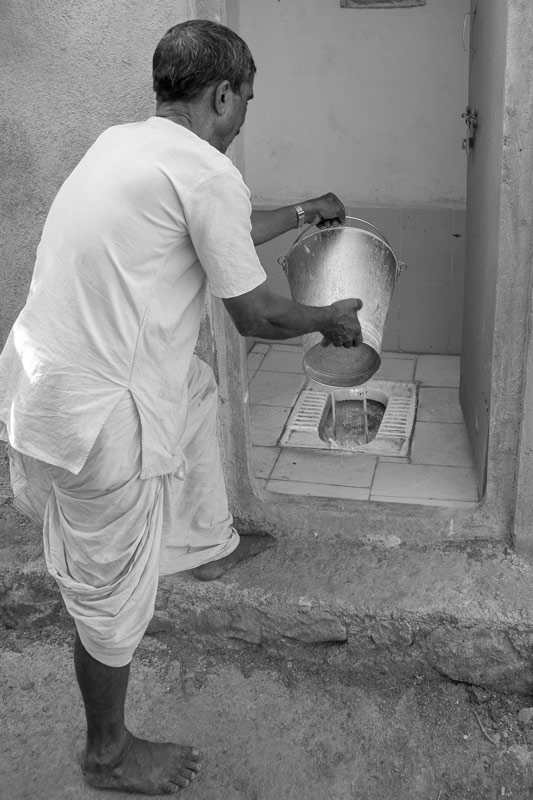
A pit latrine being flushed after use in a village, Ahmadnagar district, Maharashtra
Wastewater management in India is commonly carried out through ‘on-site’ (decentralized) or ‘off-site’ (centralized) systems. An on-site system retains wastewater in the vicinity of the source in a pit or tank, and the resultant sludge is removed periodically and disposed variously. An off-site system removes wastewater from the vicinity of the source for disposal elsewhere, generally through a sewerage network that transports it to a sewage treatment plant (STP). According to a recent NITI Aayog report, about 60% of the Indian population is dependent on the on-site systems, ‘pit latrines’ being one of the most common on-site blackwater disposal systems. One such pit-latrine is depicted in the photo above. Recent sanitation statistics show that, out of a total of more than 170 million toilets constructed under Swachh Bharat Abhiyan (Clean India Mission) since 2014, more than 148 million (87%) are pit latrines, with single or double pits. Pit latrines are cheap, simple to operate, and easy to manage, and hence are ostensibly a viable solution for safe sanitation. However, due to lack of a physical barrier around the pit, the possibility of leaching out of the contaminants is high. Thus, there exists a substantial risk of microbial and chemical contamination of the groundwater downstream, which is a serious threat in areas with shallow water table. The important chemical contaminants from pit latrines include nitrate, chloride, and ammonia, while E. coli is the prominent microbial contaminant.
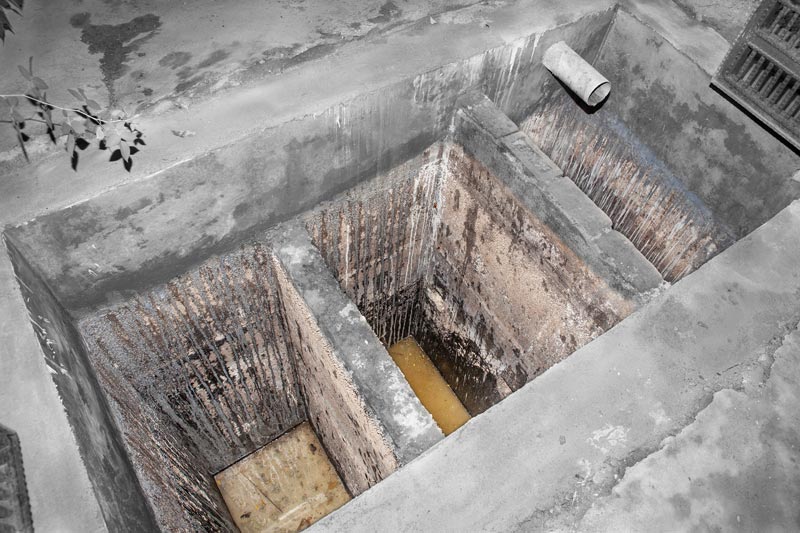
A 3-chamber septic tank in a peri-urban house in Bareilly city, Uttar Pradesh
Another common on-site wastewater disposal system is the septic tank which is a buried chamber that collects and stores domestic sewage that may contain both black- and greywater. In the tank, solids settle and digest anaerobically, which is a kind of primary treatment that helps reduce the sludge volume and also the biological load. Ideally speaking, effluent from the septic tank should be discharged to an on-site infiltration system like a soak pit which can further reduce the bacterial load. In practice, however, many premises do not have a soaking arrangement due to space constraints and/or lack of awareness, and instead the pathogenic effluent is discharged directly outside, which ultimately make way into open spaces around. From the soil there the effluent percolates down, causing pollution of the groundwater underneath. Septic tanks can have 1, 2 or 3 chambers. Though most of the treatment takes place in the first chamber, extra chambers enable longer treatment times, and thereby production of cleaner effluent at the end. The above photo depicts a 3-chamber septic tank which lacks an attached soak pit.
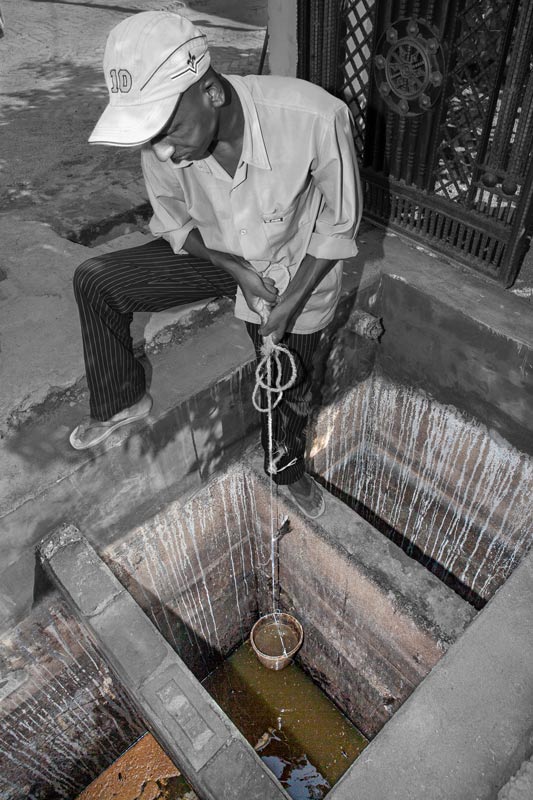
Effluent being manually drawn from a septic tank in a peri-urban house in Bareilly city, Uttar Pradesh
Depending on their capacity and usage, septic tanks get periodically filled to their capacity due to accumulation of sludge (also called fecal sludge) and the effluent. Therefore, these require emptying, which involves not only collection and transportation, but should also be followed by treatment and safe disposal of the sludge as well as the effluent. Collection and transportation of the waste is often carried out using a vacuum system but in some places this may be done manually. The above photo depicts manual collection of the effluent from a septic tank. This tank collects all the grey- and blackwater of the house at one place.
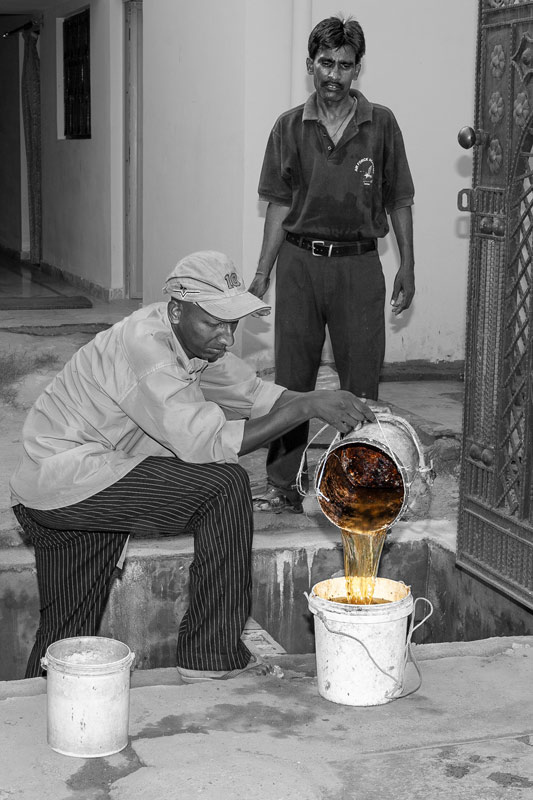
Raw effluent withdrawn from the septic tank above being prepared for disposal in a peri-urban colony in Bareilly city, Uttar Pradesh
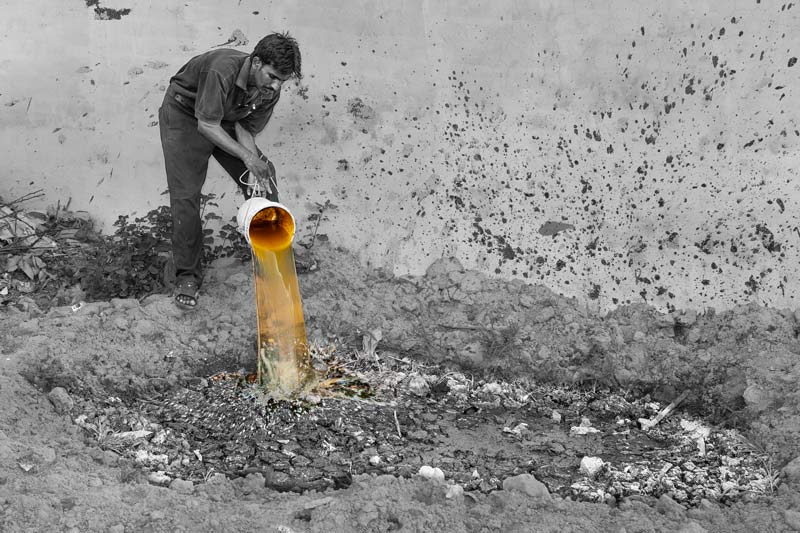
Raw effluent from a septic tank being directly disposed at a vacant plot in a peri-urban colony in Bareilly city, Uttar Pradesh
In India, treatment and safe disposal of the sludge and effluent from septic tanks is a huge problem, which in turn brings serious challenges for groundwater quality. Regarding treatment, facilities are practically non-existent. It is only recently that 500 faecal sludge treatment facilities have been sanctioned in the states of Maharashtra, Odisha and Tamil Nadu. Until their construction, and in other areas in general, fecal sludge and raw effluent will continue to be unsafely disposed without necessary secondary treatment. In many upcoming peri-urban areas, open spaces nearby are conveniently used for easy disposal of the raw effluent collected from septic tanks. One such instance is shown in the above photo, where the raw effluent collected from the septic tank shown in an earlier photo is directly disposed at a vacant plot nearby. The extent of groundwater pollution caused by such an act can be well anticipated, and also its serious implications for the drinking water in the area which is fully dependent on groundwater.
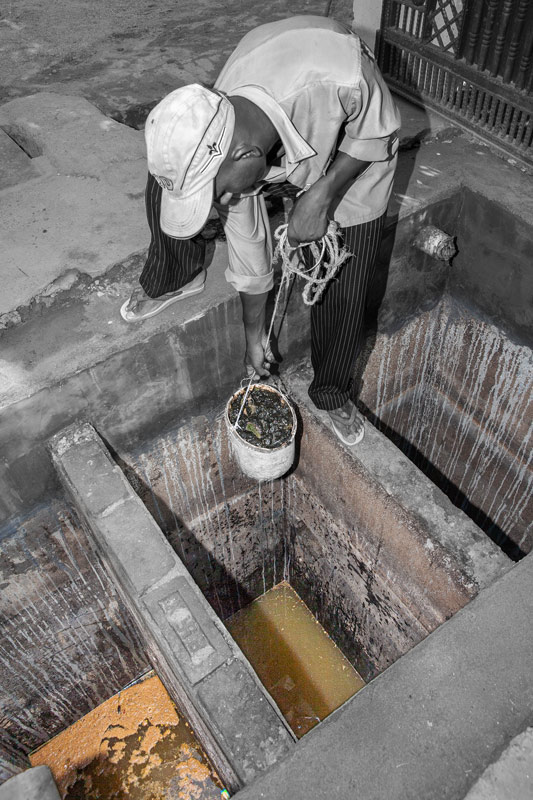
Fecal sludge being manually removed from a septic tank in a peri-urban house in Bareilly city, Uttar Pradesh
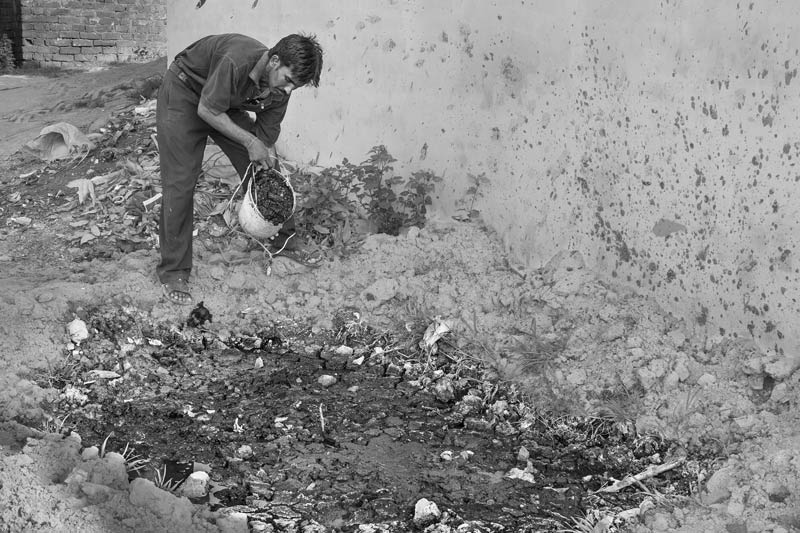
Untreated fecal sludge collected earlier from a septic tank being disposed at a vacant plot in a peri-urban colony in Bareilly city, Uttar Pradesh
The above two photos depict the fate of the fecal sludge collected from the same septic tank that was portrayed earlier. The photos depict how the untreated sludge is directly disposed at a vacant plot nearby, exposing the groundwater underneath to high risk of pollution from nitrates, chloride, ammonia, coliforms and other contaminants.
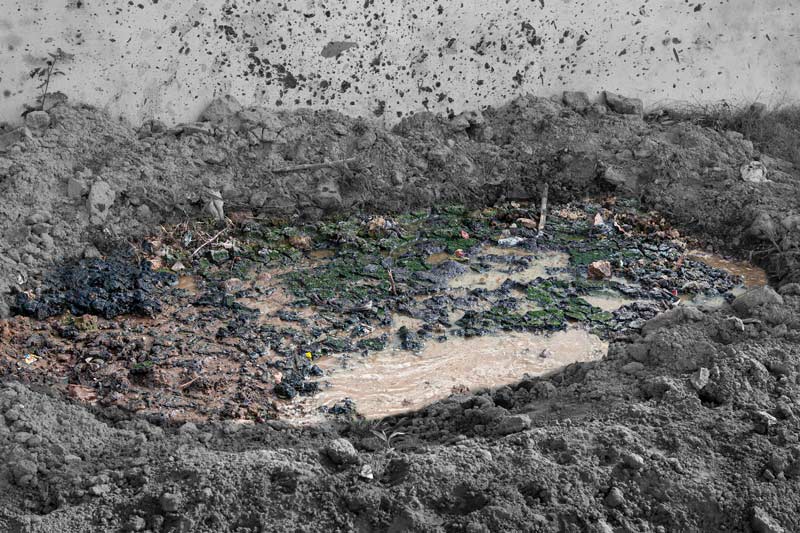
An open site with freshly disposed untreated fecal sludge and effluent from septic tank in a peri-urban residential colony in Bareilly city, Uttar Pradesh
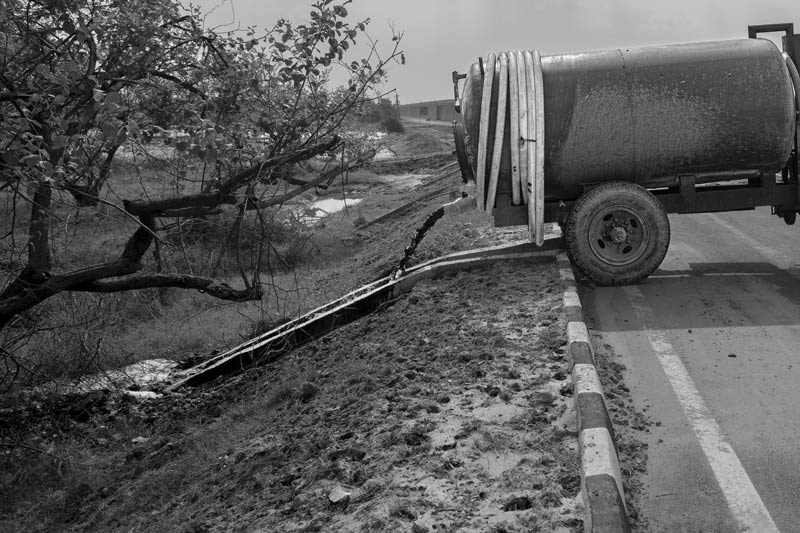
Blackwater from a septic tank emptied into a fruit orchard outside Hansi town, Hisar district, Haryana
The problem of groundwater pollution from untreated fecal sludge is not the result of manual cleaning of septic tanks alone. The problem is replicated more intensely in areas where vacuum systems are used for emptying septic tanks, and this is widespread across urban, peri-urban and rural settlements which have on-site sanitation facilities. In the absence of sludge treatment facilities, these trucks enjoy the liberty of dumping the waste in any open location. In the above photo, a sewage tank is seen being emptied into an orchard of ‘ber’ (or Indian jujube) as the farmer has purchased the raw sewage for use as fertilizer in order to raise a good fruit crop. While the blackwater undoubtedly is rich in nutrients, a point to consider is the extent of groundwater pollution that such act potentially causes, by directly introducing contaminants like nitrates, chloride, ammonia and coliforms into the soil, which further leach down to the groundwater.
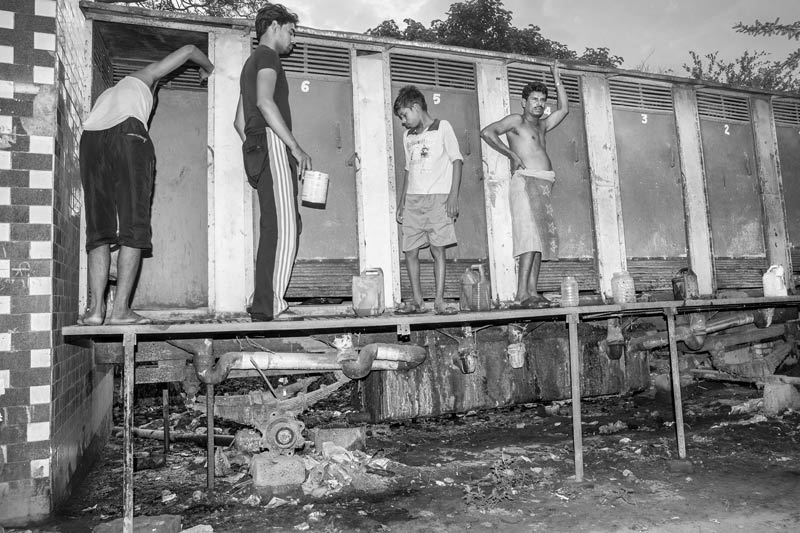
Mobile toilets provided in an informal colony in Southeast district, National Capital Territory of Delhi (NCTD)
In slums and informal urban colonies, construction of home or community toilets with pits or septic tanks becomes difficult due to shortage of space and/or financial resources. In such circumstances, mobile toilets have been provided by municipal authorities for ensuring practice of safe sanitation by the residents. Mobile toilet blocks are often connected to a single septic tank with a limited capacity, while the number of daily users is usually large. An intensely used mobile toilet block in an informal colony in NCTD is shown in the above photo.
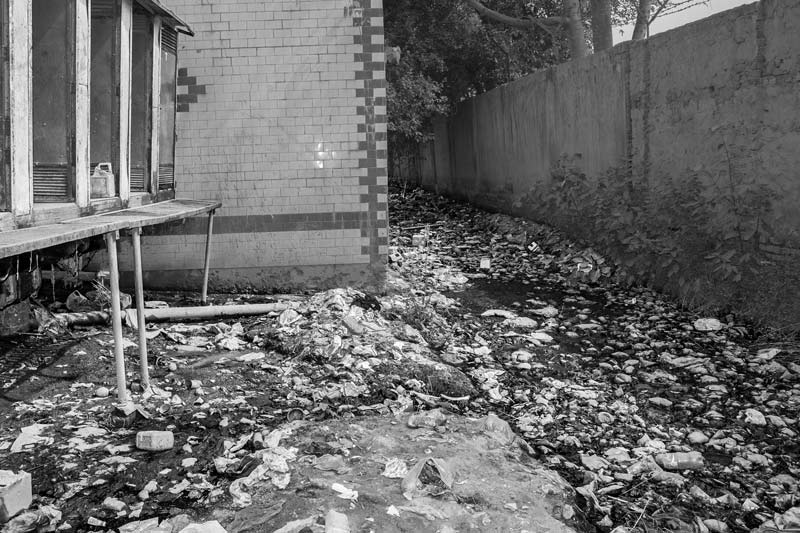
A mobile toilet block with its septic tank discharging the waste directly outside on the ground in Southeast district, National Capital Territory of Delhi
While mobile toilets ostensibly promote environmental sanitation by preventing open defecation in urban spaces, these do not necessarily ensure groundwater quality protection. Due to the high intensity of use, their septic tanks often require frequent, sometimes daily, removal of the blackwater. However, municipalities may be resource constrained in organizing regular cleaning, and instead the tanks are allowed to discharge the blackwater directly outside in the vicinity, as shown in the photo above. The blackwater collected in such spaces serve as a direct source of pollution for the groundwater underneath, even when such localities may be heavily dependent on groundwater for drinking.

A young farmer standing between irrigation canals carrying treated sewage effluent outside a village in Kanpur district, Uttar Pradesh
While decentralized on-site wastewater systems, such as the ones illustrated earlier, pose risk of groundwater pollution, the centralized off-site municipal sewage systems may be no better. These collect the city’s wastewater – both grey- and blackwater – through sewage networks and ostensibly treat them in ‘sewage treatment plants’ (STPs) before releasing the effluent back in nature. However, a recent NITI Aayog report reveals that as of 2020–21, sewage generation in the urban centres is 72,368 million litres per day (MLD), of which only 28% is actually treated. This implies that 72% of the urban wastewater remains untreated and is directly released into nature. Also, many a times, operational STPs underperform due to power or other technical limitations, or even tertiary treatment is missing. Additionally, STPs in India are based on conventional technologies, treating only biological matter, nitrogen and phosphorous, but micropollutants and other contaminants remain untreated. Despite this, treated or semi-treated sewage effluent is increasingly supplied for irrigation in nearby areas, as portrayed in the photo above. The irrigation canal carries treated sewage effluent from a STP in Kanpur city, and it is identified by the farmer as a cause of groundwater pollution in his village, the consumption of which causes serious health impacts.

Irrigating Lodi Garden lawns with treated wastewater in South-East district, National Capital Territory of Delhi (NCTD)
Another common use of treated or semi-treated wastewater from centralized municipal sewage networks is for irrigation in public parks, highway medians, and even private residential lawns in different urban centres of the country. The above photo portrays one such instance from Delhi. Lodi Garden is a large city park with an area over 90 acres. Watering such a large recreational space with wastewater offers benefits, such as cutting down the huge freshwater demand, and thus preventing over-abstraction of groundwater (as in Delhi where it is already becoming a scarce resource), and reduced landscape maintenance costs through lowered fertilization costs. However, using wastewater which is not adequately treated to an appropriate extent, can cause serious consequences for the local groundwater quality, as pollutants like nitrates, phosphorous, other chemicals and pathogens can leach down.
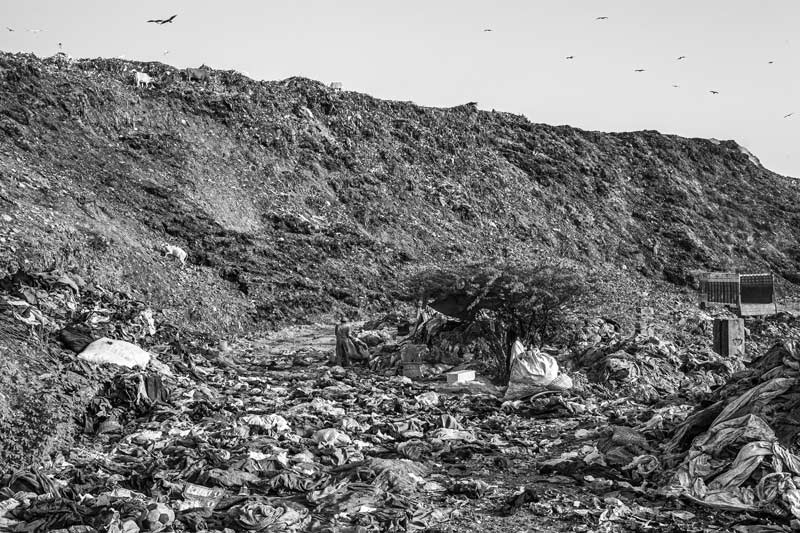
The Okhla municipal landfill in Southeast district, National Capital Territory of Delhi (NCTD)
Domestic solid waste is yet another important source of groundwater pollution. According a recent Central Pollution Control Board (CPCB) report, as much as 1.6 lakh tons per day (TPD) of solid waste is produced in India, a major part of which comprises domestic solid waste. A segment of this waste is moved to municipal landfills, where solid waste gets collected in huge mounds where it is more systematically managed in layers to facilitate its speedy decomposition. The above photo depicts one such mound at Okhla landfill in Delhi as seen in 2007. This landfill was spread over an area of 40 acres and was declared as exhausted in 2010. However, it continued to be used and only after reaching a height of 55 meters, thrice the permissible limit, it was finally decommissioned in 2018. Scientifically designed landfills that include protective provisions with respect to groundwater pollution are rare in India, which makes landfills a great hazard for groundwater. Infiltration of water from rainfall or other sources leads to dissolution of decomposed solid waste, resulting in a liquid that contains innumerable organic and inorganic compounds, which is called 'leachate'. This leachate accumulates at the bottom of the landfill and percolates through the soil into groundwater. The toxic chemicals contained in the leachate may include copper, manganese, lead, cadmium, mercury, phosphate, ammonium, nitrate etc., besides micropollutants of different kinds, all of which can make the underlying groundwater toxic for human consumption.
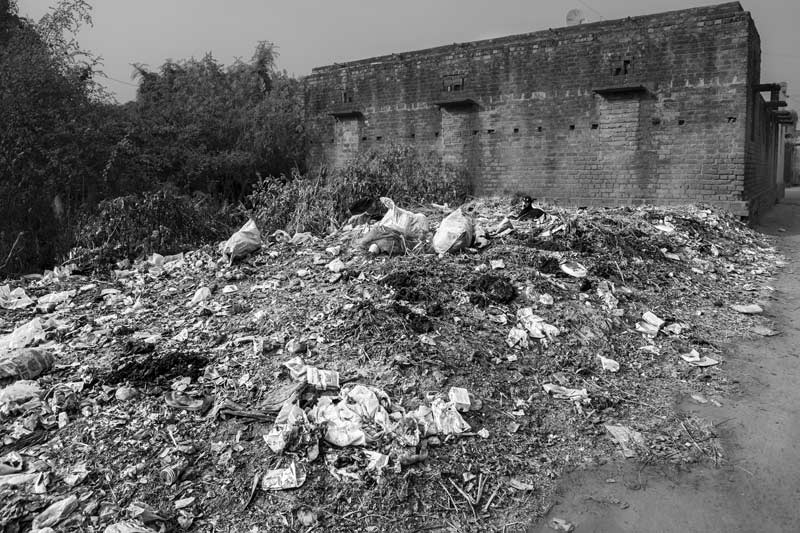
A solid waste dump in a village in Bhojpur district, Bihar
In absence of landfills for waste disposal, solid waste is disposed in dumpsites. Recent government statistics list the presence of 3184 dumpsites in the country. However, in reality, dumpsites - big and small- abound in urban and rural areas, generally being open spaces where adjacent households dump their domestic solid waste in an unsafe manner. Thus, while the nature of solid waste is the same as in the landfills, the unprotected soil base of these dumps makes these a greater source of pollution of the groundwater underneath. The above photo portrays one such solid waste dump in a rural locality where a variety of plastics, animal waste and other kinds of waste are accumulated. A rural dump like this is a greater threat to groundwater because while solid waste from the local urban dumps may be ultimately transported to a municipal landfill, that in the rural dumps are just left to decompose without any safe management, allowing the leachate containing chemicals as well as pathogens to percolate down to the aquifers. These aquifers are commonly tapped for drinking water through handpumps, wells as well as tubewells.
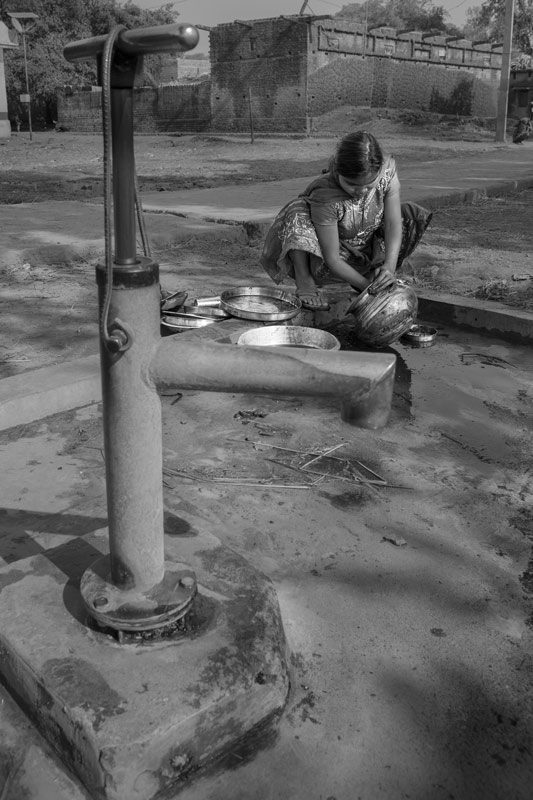
Cleaning of utensils at a community handpump in Bhojpur district, Bihar
Indian villages lack systems for proper disposal of greywater, which is the wastewater generated from not only bathing, washing, cleaning, and kitchen work at home, but also from community water points where such activities are carried out in many cases. Thus, in rural habitations, greywater is often separated from blackwater, in terms of the site of genesis as well as the system of disposal. In the absence of a proper system of treatment and disposal, the greywater is simply allowed to flow out from the site of use to be disposed into open spaces nearby. The photo above shows a woman cleaning household utensils at a community handpump.
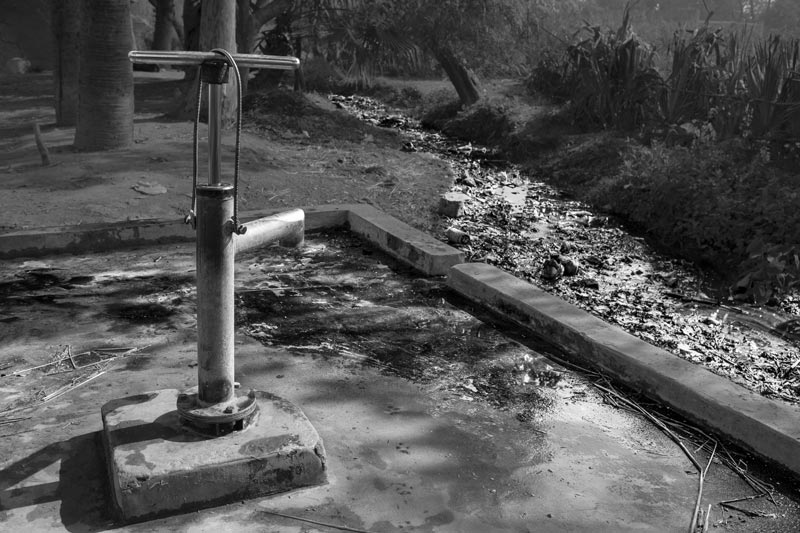
Greywater resulting from the washing of utensils (shown above) allowed to accumulate in adjacent open space in Bhojpur district, Bihar
Generally, the greywater in villages contains high concentrations of nutrients such as nitrates and its derivatives, ammonium; phosphorus and its derivatives, all from detergents and other cleaning agents; sodium from soaps; and even microbes such as fecal coliforms and salmonella. In addition, pharmaceuticals and health and beauty products may be present in appreciable concentrations. At the handpump shown in the earlier photo, there exists no proper system to channelize such polluted wastewater generated from washing and cleaning activities carried out at the site, nor any treatment facility nearby. Under such circumstances, the greywater just flows out and collects in the open space nearby, as shown in the photo above. This, in turn, percolates back into the ground, polluting the very groundwater which is withdrawn from the handpump for use.
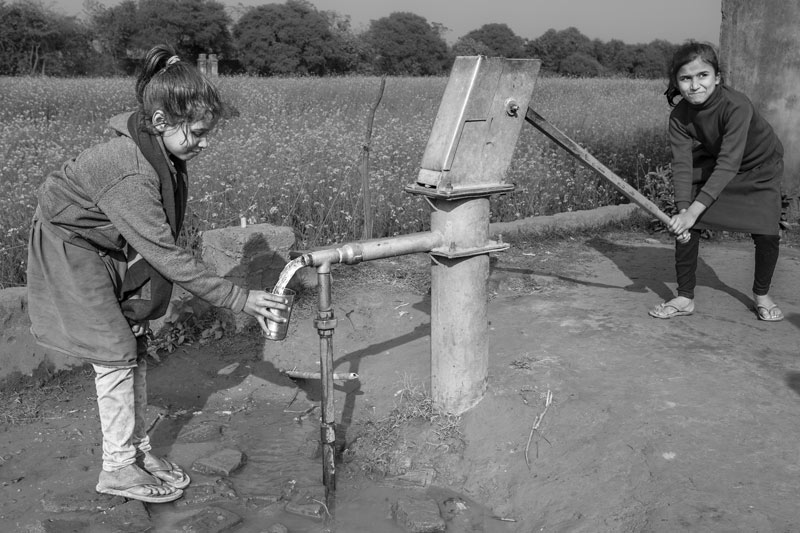
Contributing to groundwater contamination with arsenic through pumping in the Ganga-Brahmaputra basin - an example from Bhojpur district, Bihar
Another important contaminant in groundwater is arsenic which can have either a geogenic or anthropogenic origin. Geogenic source of groundwater contamination with arsenic is widely reported from the Ganga-Brahmaputra basin, where the underlying rock matrix contains high concentrations of arsenic. When groundwater in these areas is extracted by human action through pumping for drinking and other purposes, it results in release and dissolution of arsenic from the rocks into the groundwater, causing its contamination. Such an instance of human action – groundwater pumping for extracting drinking water - is depicted in the photo above. The anthropogenic pathway of arsenic contamination in groundwater is often a result of release of arsenic and its leaching from various industrial and agricultural sources such as mining residues, and use of arsenic herbicides, fungicides and pesticides. Arsenic is a toxic contaminant and its prolonged ingestion in concentrations higher than 0.01 mg/l can cause severe carcinogenic and non-carcinogenic health impacts, comprising skin, lung, kidney and bladder cancer; coronary heart disease; bronchiectasis; hyperkeratosis and arsenicosis. Arsenic contamination in groundwater above the permissible limit of has been reported from as many as 20 states and four union territories, of which Assam, Bihar, Chhattisgarh, Uttar Pradesh and West Bengal are the worst affected.
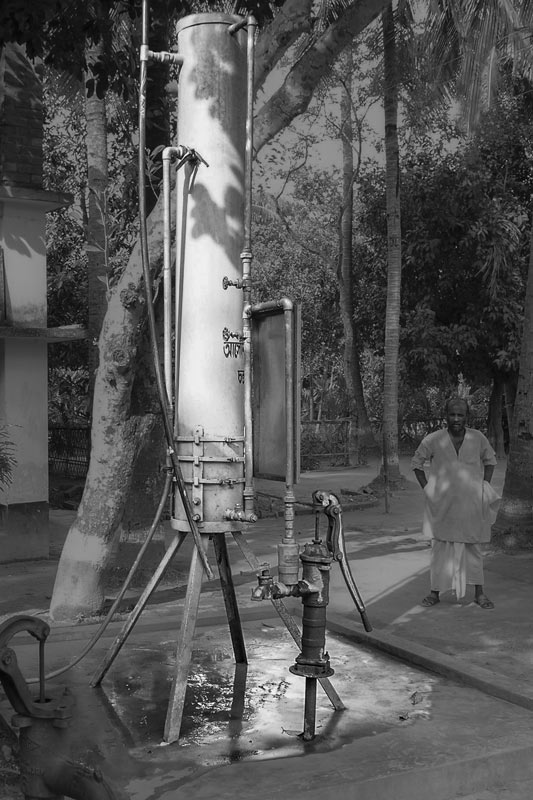
A handpump-attached arsenic removal plant in a village in Nadia district, West Bengal
In order to address the health concerns emerging from consumption of arsenic-contaminated groundwater, several technologies have been developed to treat the contaminated groundwater before drinking. Most common technologies are based on oxidation, co-precipitation, adsorption, absorption, coagulation, and membrane techniques including reverse osmosis. Hundreds of arsenic treatment plants based on one or another of these technologies have been installed in many of the affected areas, one example of which is shown in the photo above. While the arsenic treatment technologies help make arsenic-rich water safe for human consumption, unsafe disposal of the sludge generated from arsenic removal is a huge problem, as the arsenic from there can infiltrate into the soil nearby, finally leaching back into the groundwater aquifers. This exposes the same populations to enhanced risk of arsenic exposure through increase in the existing groundwater contamination.
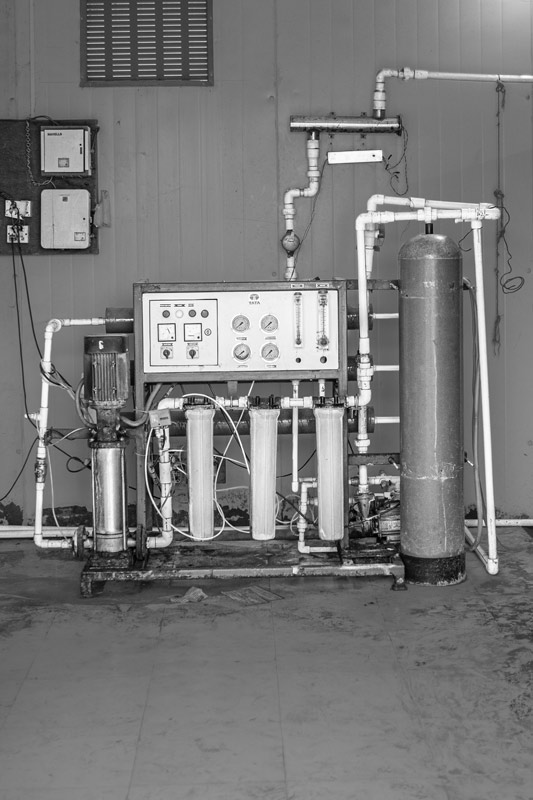
A community-scale reverse osmosis plant for defluoridation in a village in Bathinda district, Punjab
Besides arsenic, groundwater is contaminated with geogenic fluoride, iron, salinity as well as anthropogenic micropollutants such drugs, agrochemicals, personal care products, and industrial additives. Most of these can be removed through reverse osmosis (RO) plants, which uses energy to push water through a membrane with tiny pores. The membrane stops many contaminants while allowing water to pass through. Considering the benefits of RO plants, and the increasing groundwater pollution, these are being increasingly installed at domestic and community scales all over urban and rural India. One such example is shown in the photo above, which has been installed in a fluoride-affected village in Punjab. While ROs bring the benefit of supplying safe drinking water in areas where water is contaminated, improper disposal of the large amount of ‘reject water’ generated from the RO plants is a huge threat for groundwater quality.
Groundwater pollution is a serious problem in India, and its expanse and implications are immense. This photo story has outlined how domestic wastewater and solid waste as well as drinking water sources contribute to this process as sources of pollution. The pollutants from these sources have the potential of finding their way into the local groundwater aquifers, by percolating down through the soil. Thus, each of these sources can potentially introduce serious contaminants into the aquifers. For example, blackwater from on-site sanitation systems can add nitrates, ammonia, phosphorous, coliforms and other pathogens. Similarly, greywater from on-site sources can lead to leaching of ammonium, phosphorus and its derivatives all from detergents and other cleaning agents, sodium from soaps, micropollutants from pharmaceuticals and personal care products, and even pathogens. Incompletely treated municipal sewage which contains both black- and greywater can pollute groundwater even more seriously. The consumption of polluted groundwater without treatment can have serious public health implications, while improper disposal of the sludge and reject water from drinking water purification systems in affected areas serves to feed into the loop, further strengthening the pollution. The use of polluted groundwater for irrigation serves to introduce the contaminants in the food cycle and also directly impacts the health of farmers who work in the polluted water. Groundwater pollution by the different direct sources ultimately thwarts the progress towards sustainable development goals (SDGs) and impedes enjoyment of the human rights to water, health, education, livelihoods and development by the affected women, men and children. There is thus a need to immediately recognize the gravity of the problem and undertake appropriate measures to remedy the situation.